Educational Games
As the gaming industry was growing, a lot of games has been developed and a lot of genre were also gaining success. One of the first important genre of game are the educational games, which main purpose is to help people to learn about certain subjects, expand concepts, reinforce development, understand an historical event or culture, or assist them in learning a skill as they play. Thanks to the advent of personal computing, the 1980s saw the evolution and commercialisation of this new kind of games. These games were drew from video arcade and console game methods, incorporating narrative and visual elements from popular culture, and they targeted primarily elementary-aged children. Companies like the Minnesota Educational Computing Corporation (MECC), the Learning Company, were early pioneers, producing titles like Oregon Trail, Reader Rabbit, Number Munchers and Math Blaster
Lemonade Stand (1982)

Created in 1973 and brought to the Apple II platform in 1979, Lemonade Stand is one of the oldest and most popular educational games of all time even if the gameplay was very simple: players have to organize a lemonade stand, choosing the amount of ingredients to buy, how to advertise, and the price of a single lemonade. All of these choices, as well as uncontrollable factors like weather, will make your lemonade stand a success or a failure. Despite a basic premise, the game was actually teaching players complex lessons about business and economics and was one of the earliest to use a gaming platform to do so. Lemonade Stand, and others early economics-based games like M.U.L.E., would inspire a large number of future games including Lemonade Empire, Lemonade Tycoon, Hot Dog Stand, and even the school-inappropriate-but-still-educational Dope Wars to name a few.
The Oregon Trail (1985)
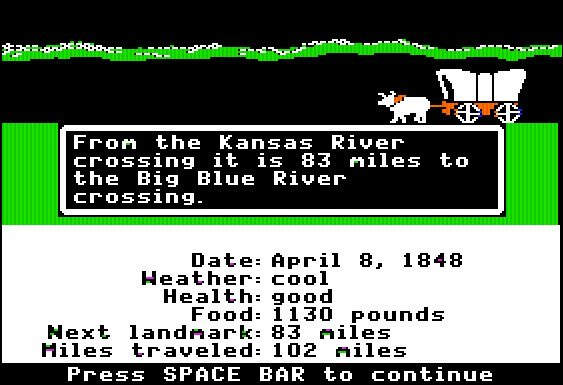
Oregon Trail has been one of them most played and remembered game of this period. In a first time this game was realized for students of Minnesota during the 70s, but afterwards, during the 1985 it was released on Apple II: it was a total success and a lot of modifications and updates were made. Even if the gameplay (it just ask players to lead a family of settlers along the Oregon) and the graphics were really simple, the game was the first to show just how engaging a game with an educational context could be.
Odell Lake (1986)
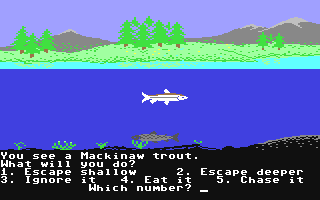
Odell lake was developed in 1986 and it was a simulator game where the player have to personify one of the six species of fish living in the Odel Lake, a real lake located in Oregon. The main goal of the player is to keep the fishing alive avoiding predators, eating food, and exploring the lake. The smarted you are, the more points you earn; meanwhile a single error can lead you to the end of the game. MECC, the developer also responsible for Oregon Trail, would later release Down Under, which expanded the concept to the Great Barrier Reef. Teaching kids about ecosystems and wildlife, Odell Lake was one of the first science-focused educational games on the market.
Reader Rabbit (1986)

Reader Rabbit is among the most influential and successful educational games of all time. Beginning with the release of the original Reader Rabbit in 1986, the game has taught scores of toddlers and young students how to read and spell through simple but fun mini-games. Over the years, The Learning Company has added many more titles to the Reader Rabbit series (branching out to math and higher grade levels), which continue to be popular educational titles in homes and schools today. Reader Rabbit was one of the first educational gaming brands to become a household name and with a new title for the Nintendo Wii announced in 2011, it remains a powerful force in the educational market today.
Munchers (1987)
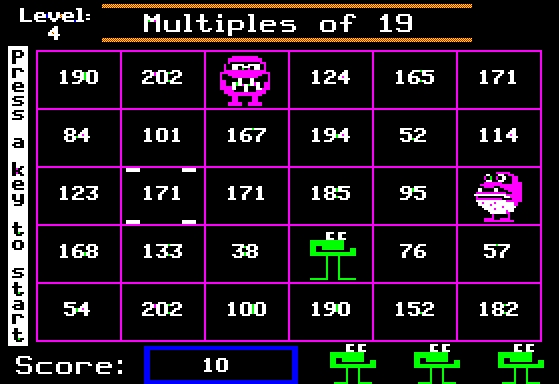
As it turns out, munching numbers is a whole lot more fun that just doing problems out of a math book, even if the educational outcome is the same. In this popular game, students must “munch” all of the numbers that fit into a specific category. A correct answer yields a fun cut-screen. An incorrect one means getting eaten by a monster (called Troggles in the game). Popular during the 1980s and ’90s, the game was another major success for the Minnesota Educational Computing Consortium and would later evolve into Math Munchers in the mid-’90s, a title that’s still available today. Number Munchers was among the first to transform basic math problem solving into something students actually look forward to doing, a hallmark of many educational games today.
Math Blaster (1987)
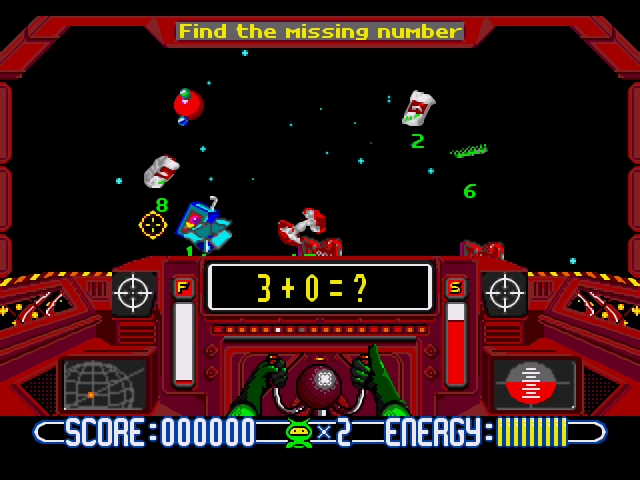
Just as munching added a fun element to math lessons, so did blasting. In fact, this popular concept yielded numerous later iterations, allowing students to blast everything from algebra to reading. Like Number Munchers, Math Blaster helped turn boring math exercises into something students could look forward to, helping change the educational gaming scene for the better. The Blaster series of games was incredibly successful and it’s easy to find variations on the theme today that cover a wide range of topics and grade levels.
SimCity (1989)

SimCity was the brainchild of legendary game designer Will Wright and was the first of many successful games to be released by the Maxis software company. Players take on the role of the mayor of an imaginary city (or a real one), managing the day-to-day affairs of planning, spending, and allocating resources. Natural disasters, revolting citizens, and unexpected obstacles kept the game challenging, helping players build serious problem solving skills in the process. The recipient of numerous awards, SimCity proved that games did not need to be winnable to be both fun and educational. Today, there are dozens of Sim titles that players can choose from and countless games inspired by the open-ended gameplay pioneered by the game.
Treasure Mountain! (1990)
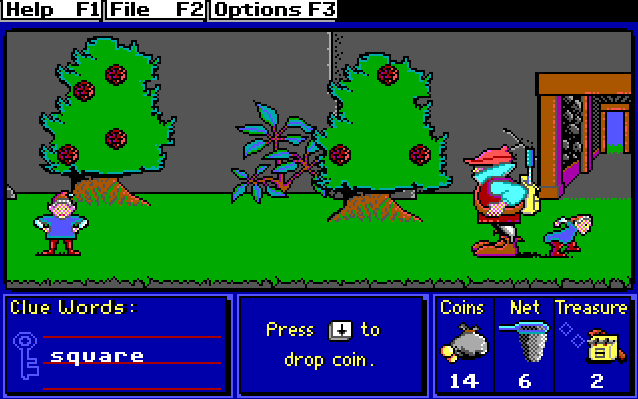
Treasure Mountain! is part of The Learning Company’s incredibly successful Super Solvers series. Gameplay is pretty simple, as players climb a mountain, answering riddles, finding clues, and collecting treasures along the way. Puzzles focus on reading, critical thinking, and math. While somewhat repetitive, the game is incredibly addictive. The structure of Treasure Mountain! is very similar to a number of educational games and platforms today, which reward students with different levels and encourage them to collect items to advance.
External Links
- [Visited on 06/11/2014] Image taken for fair use from: msu.edu
- [Visited on 06/11/2014] Image taken for fair use from: ign.com
- [Visited on 06/11/2014] Image taken for fair use from: gamefaqs.com
- [Visited on 06/11/2014] Image taken from: myabandonware.com
- [Visited on 06/11/2014] Image taken for fair use from:giantbomb.com
- [Visited on 06/11/2014] Image taken for fair use from: gamefabrique.com
- [Visited on 06/11/2014] Image taken for fair use from: theregister.co.uk
- [Visited on 06/11/2014] Image taken from: myabandonware.com
All images are fair use intended.